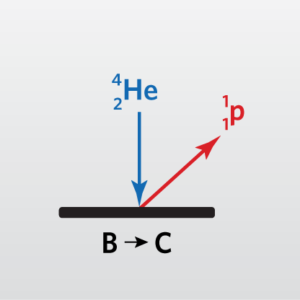Nuclear Reaction Analysis (NRA)
Home » Our Techniques » Spectroscopy » NRA
Nuclear Reaction Analysis (NRA) is used to measure low-Z elements (e.g. carbon, nitrogen, oxygen, and boron) in thin films. During NRA analysis, the primary projectile induces a nuclear reaction with the low-Z nuclei in the thin film, leading to the ejection of particles with kinetic energies characteristic of specific nuclear reactions (i.e. particular elements).
Very few labs can offer NRA commercially or match EAG’s depth and breadth of experience, accurate data and person-to-person service.
NRA can be used to quantitatively measure the total concentration of B, C, N, O and Li present in a film. These elements can be measured at a much lower concentration using NRA compared to RBS. By performing NRA in combination with RBS, the concentrations of light elements in thin films can be determined.

Ideal Uses of NRA
- Measuring low levels of B, C, N, O and Li in thin films
Strengths
- Non-destructive compositional analysis
- Quantitative without standards
- Whole wafer analysis (up to 300 mm)
- Conductor and insulator analysis
- Low-Z element sensitivity
Limitations
- Large analysis area (~1-2 mm diameter)
- No depth resolution
- Each element requires a specific projectile, so multiple measurements maybe necessary depending on the elements of interest
NRA Technical Specifications
- Elements Detected: C, N, O, B, Li
- Detection Limits: 0.5 – 2 at%
- Depth Resolution: None
- Imaging/Mapping: No
- Lateral Resolution/Probe Size: ~1-2 mm
Would you like to learn more about using Nuclear Reaction Analysis (NRA)?
Contact us today for your Nuclear Reaction Analysis (NRA) needs. Please complete the form below to have an EAG expert contact you.